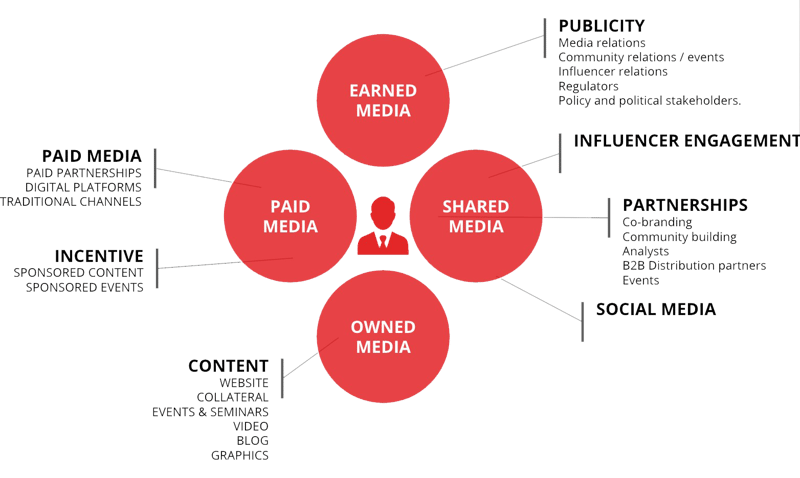This one is for businesses and their executives who have been struggling to successfully share their story with the world. Leaders who are convinced they have a message that key media titles and their readers want to hear, but haven’t succeeded in getting the story out there. Give me 1000 words to explain why and how you can do better.
PR has always been a crucial element of the marketing mix and was always considered as the powerful and - above all – free way to build a brand and profile. If your story was relevant and important, media would probably write about it. The trade was: media could tell a good story and the company got free publicity, which helped to boost brand and credibility – great deal.
The PRevolution
But times have changed. The digital revolution has transformed everything, including the way your company or brand interacts with the outside world.
PR as we have always known it, is dead.
We now call it ‘earned media’ and its relevance for companies has changed dramatically. Apart from earned media, we now also have ‘owned’, ‘shared’ and ‘paid’ media (see image).

The share of earned media in the PR landscape has been slashed if you compare it to 10 years ago. The digital revolution has completely reshuffled the definition of what PR is, causing a, as you could call it, PRevolution.
To clarify: we’re not talking about ‘defensive’ reputation, issue or crisis management here. This transformation has mainly influenced the way marketing is done: redefining what it means to proactively build a brand and profile with the help of media and channels.
Exponential growth of channels
While free publicity still adds value to your communications efforts, it’s no longer the standard way to reach that target audience. The number of other channels companies can use to reach out to the world has grown exponentially. That has a big impact. Owned, shared and paid channels have taken up a big chunk of possibilities for companies to tell their stories and you need an integrated approach to use them to your full benefit.
All these new ways and channels allowing companies to express who they are, what they stand for, and what they want to change in the world, have profoundly changed the meaning of PR in three ways:
1. Direct Communications
Nowadays companies no longer only rely on major publications to get their message across, build their brand and grow their profile. They can communicate much more directly with their stakeholders online, and thus have many more choices to reach prospects, clients, employees, investors, analysts, politicians, policy groups, regulators and so on. Especially via owned, shared and paid channels, such as a corporate website, blogs, vlogs, etcetera, the options are numerous to share your message.
2. Companies regain control. And with control, comes responsibility
So, in a way the function of direct marketing is back. Digital channels lower the barrier for companies to have a voice. Companies can rely on their own channels to share content with their target groups. This means they are in control of the message. But that control also comes with another responsibility: having a thoroughly thought through communications strategy that includes all different channels. This is now more important than ever. Publishing content is no longer about posting a tweet or two. It’s about redefining the story of your brand – making sure it’s authentic, engaging and transparent. It’s about having values and a sense of purpose as a company. That’s what society demands.
If you’re able to master the art of authentic storytelling and understand how to make your company’s story relevant for the world around you, you might have found an impactful way to build your company’s or CEO’s or other executives’ profile. This is exactly what thought leadership is about: inspiring people and encouraging them to share your story with their network.
A company that is truly understanding the power of owning its brand story and sharing it in a way it has impact, is clothing brand Patagonia. The company has put sustainability at the heart of its successful business model and it recently expressed its desire to save the planet. This bold choice has brought lots of growth, not just as a thought leader, but also in sales.
3. Two sides of the same coin
Every consumer these days has the power to share their opinion, complaints, compliments and stories – 24/7, and on a global scale. The leverage effect of social and digital channels is enormous. For companies, there are two sides of the same coin. When companies or consumers love what you do and say, they will become a fan and share it with other companies or people (which is easier said than done). On the other hand, complaints about your CEO’s behaviour or inferior customer experiences are shared without hesitation. Child labour issues of big brands are being exposed globally. And #metoo has been trending for months and brought down the reputation of many companies across the globe.
Social channels are a playground for those with an opinion and people who want to be heard. It's important companies and brands are fully aware of the power that has been granted to the people in the last decade, because it's those people who have the power to totally make or break a brand.
And while media still play a major role in this ecosystem, its power has clearly shifted: they’re now sharing their stage with those people and companies eager to share their opinions.
New opportunities
In short: the way your company can share its story with the world has changed. Your company gained more control, but with that control, comes another responsibility: that of having an integrated communications strategy in place to make available channels work for you, instead of them firing back on you. Especially now that consumers have more power as well. All these new different channels haven’t made it easier to define that strategy compared to 20 years ago. But these new channels have created a whole new pool of opportunities, one of them being:
engage directly, intensively and in real time with your stakeholders.
None of this is brand new. It’s been around for a number of years now. Nonetheless, many companies aren’t yet making full use of this new way of communicating. And there is a lot to win: a bigger reach and therefore more – loyal – customers.
How beautiful is that?
